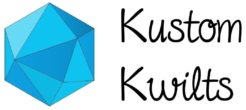How many times have you looked at a quilt top and been totally stumped on how you would quilt it? I feel like this is a skill that really is developed over time and trial and error. I’ll be the first to admit that my very first quilts–after quilting–didn’t really showcase the quilt pattern with the quilting as they could have. My quilting designs made little sense and didn’t work with the existing pattern to make the quilt pop. Basically, I was just quilting to get it done and keep all the layers together.
It’s a little difficult to see the quilting, but it’s orange thread in squiggly lines…obviously my photography skills were lacking as well 😉 This was the first quilt I ever made, in October of 2011.
I think that typically, for beginning quilters, the quilting is all about function. It’s difficult enough to remember 1/4″ seam allowance, minding your bobbin so you aren’t sewing without thread, etc. I know that I was just relieved to be finished, and I was very proud of the quilting at the time.
Fast forward 5 years, and quilting is now my favorite part. I’m enamored with the process of evaluating a quilt top, selecting batting, figuring out what quilting design will best display the awesomeness of the quilt pattern. I know that I still have a long way to go, and I pour over Instagram, Pinterest, blogs, books, etc. to find every piece of information and inspiration I can get before I start planning to quilt a quilt.
I recently had the opportunity to quilt my first Double Wedding Ring quilt. My client’s quilt was pieced entirely by her grandmother (prior to her passing) from vintage fabrics and feed sacks. It was the greatest honor to be trusted with a family heirloom. I used plastic overlays to audition different quilting designs, and finally came up with a combination of a few simple designs that I felt would work well together and really make the quilt pop.
 |
| This was actually the first row that I quilted with a feather. I hated them and ripped them all out and started over. |
I stewed over the newly blank quilt after ripping the first row out and finally re-started.
I was very pleased with the outcome and can’t wait until I can return it to the customer.
Here is the full quilt:
I love the finished look of ruler work with free motion quilting. I think the structure really works well with the free-flowing quilting and I can’t wait to play around with this some more. I can’t wait to see where my work is in another 5 years…




